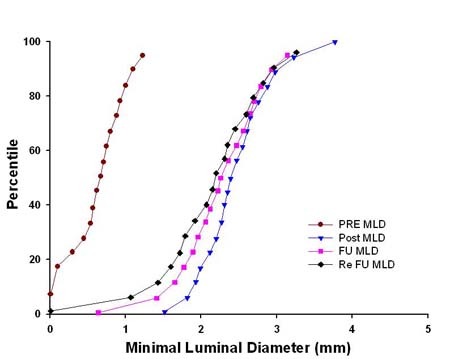| єя«•«ьљƒ : ±Єњђ
|
ЅҐЉцєш»£ - 530765 164 |
| Three and Half Year Angiographic Follow-Up of Patients Treated with Sirolimus-Eluting Stents.
Late Catch-up Phenomenon 3.5 years after Sirolimus-Eluting Stent Implantation
|
| мЭЄм†ЬлМАнХЩкµР лґАмВ∞л∞±л≥СмЫР мЛђмЮ•лВік≥Љ |
| мЦСнГЬнШД, м†ХмЮђнШД, мДЬкіСмЫР, кєАлПЩкЄ∞, кєАмЪ©л≥µ, кєАмЫЕ, мД§мГБнЫИ, кєАлМАк≤љ, кєАлСРмЭЉ, кєАлПЩмИШ |
Background: Although several randomized trials have shown that SES substantially reduce in-stent restenosis, long-term angiographic outcome after SES implantation has not previously been investigated in real world practice. Methods: This study was conducted for 115 patients with 154 lesions who had undergone SES implantation between Feb 2004 and June 2006 and received first and second angiographic follow-up. We compared the coronary and QCA results between the first and second angiographic follow-up.
Results: Mean durations from SES implantation to first and second angiographic follow-up were 7.0 ± 3.7 and 43.7 ± 10.4 months, respectively. Number of stents was 1.26 ± 0.49 per lesion. Total stented length and mean stent diameter were 32.6 ± 15.7 mm and 2.98 ± 0.34 mm. The rate of in-stent resteosis was 3.9% at first angiographic follow-up. Of the 154 coronary lesions, TLR was performed in 3 (2.6%) patients with 4 (2.6%) lesions at first angiographic follow-up. Therefore, coronary and QCA comparison between first and second coronary follow-up were available in 112 patients with 150 lesions.MLD at second follow-up was significantly smaller compared with MLD at first follow-up (2.19 ± 0.69 vs. 2.33 ± 0.56; p< 0.001) (Figure). In-stent late lumen loss between first and second follow-up was significantly larger compared with that between SES implantation and first follow-up (0.27 ± 0.58 vs. 0.13 ± 0.41; p=0.000). At second angiographic follow-up, the rate of in-stent restenosis was 9.3% (14/150) and additional TLR was performed in 9 patients (8.0%) with 10 (6.7%) lesions. Definite very late stent thrombosis developed in 3 (2.7%) patients with 3 (2.0%) lesions. Stent fracture and coronary aneurysm were found in 11 (7.3%) and 12 (8.0%) lesions, respectively. There were 4 (3.6%) acute MI and 4 (3.6%) stroke between first and second angiographic follow-up. Conclusions: Late catch up phenomenon accompanied with adverse angiographic and clinical events was found at long-term angiographic follow-up after SES implantation.
|
|
|
Warning: getimagesize(/home/virtual/circulationadmin/renewal/econgress/conference/abstract/img_files/3YA_FU_Down.jpg) [function.getimagesize]: failed to open stream: No such file or directory in /home/virtual/circulationadmin/new/econgress/conference/manage/schedule/view_abstract.php on line 164

|
|





